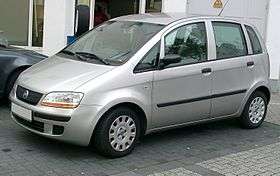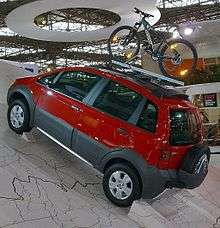Fiat Idea
| Fiat Idea | |
|---|---|
 | |
| Overview | |
| Manufacturer | Fiat |
| Also called | Lancia Musa |
| Production |
2003–2012 (Italy) 2005–2016 (Brazil) |
| Assembly |
Turin, Italy (Mirafiori plant) Betim, Brazil (Fiat Automóveis) |
| Designer | Giorgetto Giugiaro |
| Body and chassis | |
| Class | Mini MPV (M) |
| Body style | 5-door MPV |
| Layout | Front-engine, front-wheel-drive |
| Platform | B platform (Project 188) |
| Related |
Fiat Punto (188) Lancia Musa Lancia Ypsilon |
| Powertrain | |
| Engine |
Petrol engines: 1.2 L FIRE I4 1.4 L FIRE I4 1.6 L E.torQ I4 (Brazil only) 1.8 L X18XE I4 (Brazil only) 1.8 L E.torQ I4 (Brazil only) Diesel engines: 1.3 L Multijet I4 1.6 L Multijet I4 1.9 L Multijet I4 |
| Transmission |
5-speed automatic 5-speed manual 6-speed manual |
| Dimensions | |
| Wheelbase | 2,510 mm (98.8 in) |
| Length | 3,930 mm (154.7 in) |
| Width | 1,700 mm (66.9 in) |
| Height | 1,660 mm (65.4 in) |
| Curb weight | 1,275 kg (2,811 lb) |
| Chronology | |
| Predecessor | Fiat Palio Weekend (Europe) |
| Successor |
Fiat 500L Fiat Argo (Brazil) Jeep Renegade (Brazil) |
The Fiat Idea (Type 350) is a front-engine, front-wheel drive, five-door, five-passenger high-roof B-segment mini MPV manufactured and marketed by FCA for model years 2003-2012 — over a single generation with one intermediate facelift.
As FCA's first entry in the mini-MPV market,[1] the Idea's exterior was designed by Giorgetto Giugiaro, its interior was designed by Fiat's Centro Stilo, and its platform is shared with the second-generation Fiat Punto. The Idea is noted for its centrally located instrument cluster, high H-point seating, and flexible seating — including reclining, sliding and folding rear seats. Its seating design uses biometric principles developed by Antonio Dal Monte at the Italian National Olympic Committee's sport medicine institute[1]
Marketed along with the Lancia Musa, an upscale, rebadged variant, the Idea was superseded by the Fiat 500L.
The Idea nameplate is an acronym for Intelligent Design Emotive Architecture.[2][3]
Features
Standard features included six airbags, isofix attachments, automatic door locks, fire prevention system (fuel cut off), ABS braking with brake force distribution, an anti-slip regulation system to limit wheel slip in cases of reduced grip, traction control, electronic stability control, hill-holder, electric speed-sensitive power steering system, 40-20-40 split rear seating, and a headlight delay system marketed as Follow Me Home.[1]
Optional features included a panoramic sunroof, parking sensors and dual-zone climate control.[1]
Engines
The Fiat Idea engines are all Euro 4 compliant. The petrol engine is the 1.4-litre 16 valve 95 PS (70 kW; 94 hp), available with five- and six-speed gearboxes, and the diesel 1.3-litre 16 valve MultiJet units, with 70 PS (51 kW; 69 hp) or 90 PS (66 kW; 89 hp). All of these engines can be matched with a clutchless 5-speed sequential manual shift with a selectable, fully automatic mode — as robotised manual gearbox marketed as Duologic.
| Model | Engine | Displacement | Power | Torque |
|---|---|---|---|---|
| 1.2 Fire 16V | I4 | 1242 cc | 80 PS (59 kW; 79 hp) @ 5000 rpm | 114 N⋅m (84 lb⋅ft) @ 4000 rpm |
| 1.4 8V | I4 | 1368 cc | 77 PS (57 kW; 76 hp) @ 6000 rpm | 115 N⋅m (85 lb⋅ft) @ 3000 rpm |
| 1.4 FIRE 16V | I4 | 1368 cc | 95 PS (70 kW; 94 hp) @ 5800 rpm | 128 N⋅m (94 lb⋅ft) @ 4500 rpm |
| 1.3 16V Multijet | I4 | 1248 cc | 70 PS (51 kW; 69 hp) @ 4000 rpm | 180 N⋅m (130 lb⋅ft) @ 1750 rpm |
| 1.3 16V Multijet | I4 | 1248 cc | 90 PS (66 kW; 89 hp) @ 4000 rpm | 200 N⋅m (150 lb⋅ft) @ 1750 rpm |
| 1.6 16V Multijet | I4 | 1598 cc | 120 PS (88 kW; 120 hp) @ 4000 rpm | 300 N⋅m (220 lb⋅ft) @ 1500 rpm |
| 1.9 8V Multijet | I4 | 1910 cc | 100 PS (74 kW; 99 hp) @ 4000 rpm | 260 N⋅m (190 lb⋅ft) @ 1750 rpm |
Brazil
The Brazilian version of the Idea was launched in late 2005. The engines available are the new 1.4-litre 8-valve 86 hp (64 kW) Fire engine (the same as in the Grande Punto) and the latest version of the GM-sourced Powertrain 1.8-litre 8-valve 114 hp (85 kW) engine.[4] Both have flexible fuel technology, which lets the driver use either gasoline or ethanol.
This version has a longer wheelbase and height compared to the European version.[5] The interior design is taken from the Fiat Palio Mk. III, and adapted to the South American market. It also has a panoramic glass roof as an option, known as the SkyDome.
The Idea is exported in two different trim levels (the ELX with the 1.4-litre engine and the HLX with the 1.8 engine) and it has four airbags, anti-lock braking system with EBD; parking, rain and lights sensor, security laminated glass, the SkyDome, 15" alloys, Bluetooth phone system, and leather seats among other features.
Over 170,000 Ideas have been sold in Brazil since its launch (2005). In 2010 the Idea received another facelift with new front, rear and door handles.
Idea Adventure

The Idea Adventure is a mini crossover version that was launched in September 2006 in São Paulo, Brazil. It has a revised suspension, tires are Pirelli Scorpion 205/70 R15, a protective body kit, specially designed 15" alloys, interior mods like the white instruments, the specially designed seats with leather, and a standard safety equipment which features double front and side airbags, ABS brakes with EBD. In 2009 the whole Adventure line (Idea, Doblò, Strada and Palio Weekend) was equipped with a locking differential. The line was rebadged as Adventure Locker. Idea Brazilian Facelift
During his visit to Rio de Janeiro in July 2013, Pope Francis chose to ride in a Fiat Idea for his public appearances, instead of the expensive and secure vehicles usually used by dignitaries and popes.
References
- 1 2 3 4 "Fiat Idea Press Release". Fiat. 19 February 2004.
- ↑ Michael McAleer (17 March 2004). "FIAT Idea". Irish Times.
- ↑ "FIAT Idea". Fiat. 17 February 2004.
- ↑ "Fiat Idea". Fiat Cars. Retrieved 22 June 2011.
- ↑ "1991 BMW 850i Automatic". Automobile-catalog.com. Retrieved 22 June 2011.
External links
![]()